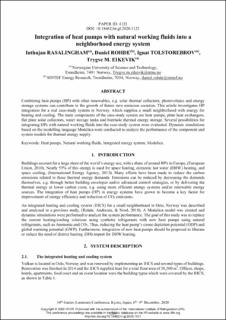| dc.contributor.author | Rasalingham, Inthujan Raveendrakumar | |
| dc.contributor.author | Rohde, Daniel | |
| dc.contributor.author | Tolstorebrov, Ignat | |
| dc.contributor.author | Eikevik, Trygve Magne | |
| dc.date.accessioned | 2021-05-06T12:33:30Z | |
| dc.date.available | 2021-05-06T12:33:30Z | |
| dc.date.created | 2020-12-11T18:01:45Z | |
| dc.date.issued | 2020 | |
| dc.identifier.isbn | 978-2-36215-040-1 | |
| dc.identifier.issn | 0151-1637 | |
| dc.identifier.uri | https://hdl.handle.net/11250/2753954 | |
| dc.description.abstract | Combining heat pumps (HP) with other renewables, e.g. solar thermal collectors, photovoltaics and energy storage systems can contribute to the growth of future zero emission societies. This article investigates HP integration for a real case-study system in Norway, which supplies a small neighborhood with energy for heating and cooling. The main components of the case-study system are heat pumps, plate heat exchangers, flat plate solar collectors, water storage tanks and borehole thermal energy storage. Several possibilities for integrating HPs with natural working fluids into the case-study system were evaluated. Dynamic simulations based on the modelling language Modelica were conducted to analyze the performance of the component and system models for thermal energy supply. Keywords: Heat pumps, Natural working fluids, Integrated energy system, Modelica. | en_US |
| dc.language.iso | eng | en_US |
| dc.publisher | IIR | en_US |
| dc.relation.ispartof | Proceedings of the 14th IIR-Gustav Lorentzen Conference on Natural Refrigerants | |
| dc.relation.ispartofseries | Sciences et technique du froid;2020:14 | |
| dc.title | Integration of heat pumps with natural working fluids into a neighborhood energy system | en_US |
| dc.type | Chapter | en_US |
| dc.type | Peer reviewed | en_US |
| dc.description.version | acceptedVersion | en_US |
| dc.source.pagenumber | 351-356 | en_US |
| dc.identifier.cristin | 1858923 | |
| dc.relation.project | Norges forskningsråd: 280994 | en_US |
| cristin.ispublished | true | |
| cristin.fulltext | postprint | |
| cristin.qualitycode | 1 | |
